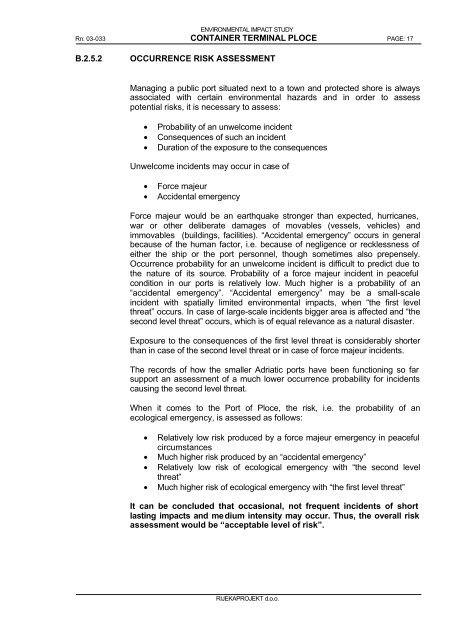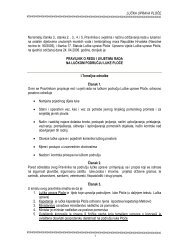HEADING PAGE - port of ploce authority * welcome
HEADING PAGE - port of ploce authority * welcome
HEADING PAGE - port of ploce authority * welcome
Create successful ePaper yourself
Turn your PDF publications into a flip-book with our unique Google optimized e-Paper software.
ENVIRONMENTAL IMPACT STUDY<br />
Rn: 03-033 CONTAINER TERMINAL PLOCE <strong>PAGE</strong>: 17<br />
B.2.5.2 OCCURRENCE RISK ASSESSMENT<br />
Managing a public <strong>port</strong> situated next to a town and protected shore is always<br />
associated with certain environmental hazards and in order to assess<br />
potential risks, it is necessary to assess:<br />
• Probability <strong>of</strong> an un<strong>welcome</strong> incident<br />
• Consequences <strong>of</strong> such an incident<br />
• Duration <strong>of</strong> the exposure to the consequences<br />
Un<strong>welcome</strong> incidents may occur in case <strong>of</strong><br />
• Force majeur<br />
• Accidental emergency<br />
Force majeur would be an earthquake stronger than expected, hurricanes,<br />
war or other deliberate damages <strong>of</strong> movables (vessels, vehicles) and<br />
immovables (buildings, facilities). “Accidental emergency” occurs in general<br />
because <strong>of</strong> the human factor, i.e. because <strong>of</strong> negligence or recklessness <strong>of</strong><br />
either the ship or the <strong>port</strong> personnel, though sometimes also prepensely.<br />
Occurrence probability for an un<strong>welcome</strong> incident is difficult to predict due to<br />
the nature <strong>of</strong> its source. Probability <strong>of</strong> a force majeur incident in peaceful<br />
condition in our <strong>port</strong>s is relatively low. Much higher is a probability <strong>of</strong> an<br />
“accidental emergency”. “Accidental emergency” may be a small-scale<br />
incident with spatially limited environmental impacts, when “the first level<br />
threat” occurs. In case <strong>of</strong> large-scale incidents bigger area is affected and “the<br />
second level threat” occurs, which is <strong>of</strong> equal relevance as a natural disaster.<br />
Exposure to the consequences <strong>of</strong> the first level threat is considerably shorter<br />
than in case <strong>of</strong> the second level threat or in case <strong>of</strong> force majeur incidents.<br />
The records <strong>of</strong> how the smaller Adriatic <strong>port</strong>s have been functioning so far<br />
sup<strong>port</strong> an assessment <strong>of</strong> a much lower occurrence probability for incidents<br />
causing the second level threat.<br />
When it comes to the Port <strong>of</strong> Ploce, the risk, i.e. the probability <strong>of</strong> an<br />
ecological emergency, is assessed as follows:<br />
• Relatively low risk produced by a force majeur emergency in peaceful<br />
circumstances<br />
• Much higher risk produced by an “accidental emergency”<br />
• Relatively low risk <strong>of</strong> ecological emergency with “the second level<br />
threat”<br />
• Much higher risk <strong>of</strong> ecological emergency with “the first level threat”<br />
It can be concluded that occasional, not frequent incidents <strong>of</strong> short<br />
lasting impacts and medium intensity may occur. Thus, the overall risk<br />
assessment would be “acceptable level <strong>of</strong> risk”.<br />
RIJEKAPROJEKT d.o.o.



